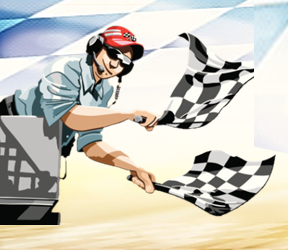
Green: This flag starts the race! A green flag means conditions are race ready, and the green flag starts the race and restarts the race after a caution.
Yellow: This flag means caution on the speedway. There may have been a wreck, a stopped car, fluids, debris, or rain. Cars must slow down and fall behind a pace vehicle while under yellow conditions.
White: This flag signals there is one lap to go in the event. Sometimes the white flag is shown during a caution period to signal the race will resume the next time by.
Checkered: The race is over, the flagman waives the checkered flag.
Red: When this flag is thrown, cars must stop immediately. Most often, the red flag is thrown after a car flips. The red can also be used after a car catches fire, or if the track is blocked from a serious crash. If a tire comes off the car and is rolling, the red flag may also be thrown especially in New Jersey.
Blue with Orange Stripe: This flag is used to let slower cars know the leaders are approaching and they must either hold their line or move to a designated area to safely let the faster cars pass.
Black: No driver wants to see the black flag. This flag means the car must pull off the racing surface. Either the driver has been involved in unsafe driving, or there are safety issues with the car. The black flag can also be pointed at a car to let the driver know officials are keeping an eye on the driving style. If the flag is simply pointed at a car, and not unfurled, the car can remain on the speedway.
Two flags rolled up in an X formation: This signals to the drivers halfway has been reached in the race.
Two flags rolled up held parallel: This signals the drivers there are two laps remaining in the event.
Open hand palm: The flagger holds out his hand and this tells the drivers there are five laps to go in the feature race. Often it’s referred to as the “hi how are ya” lap.
